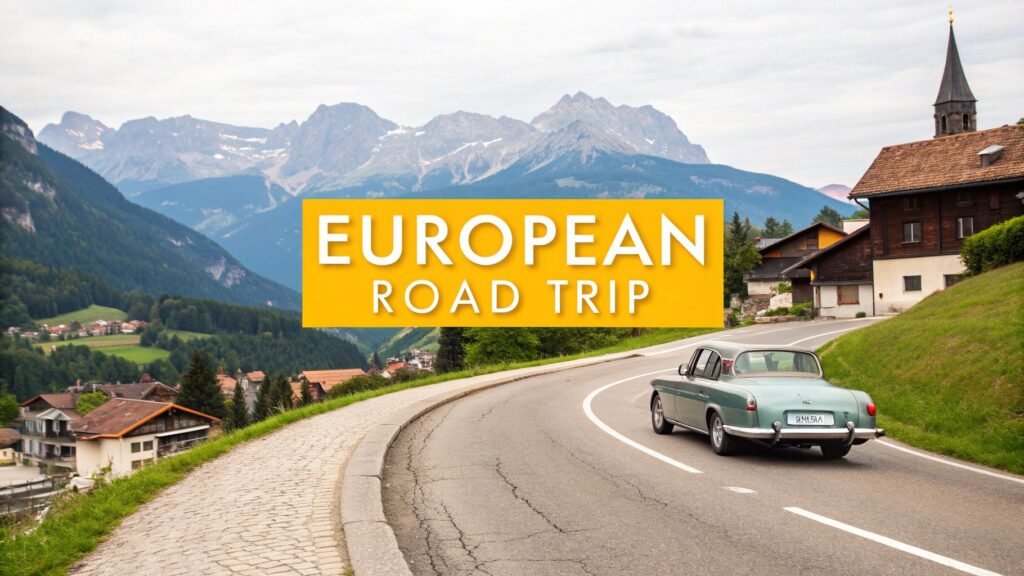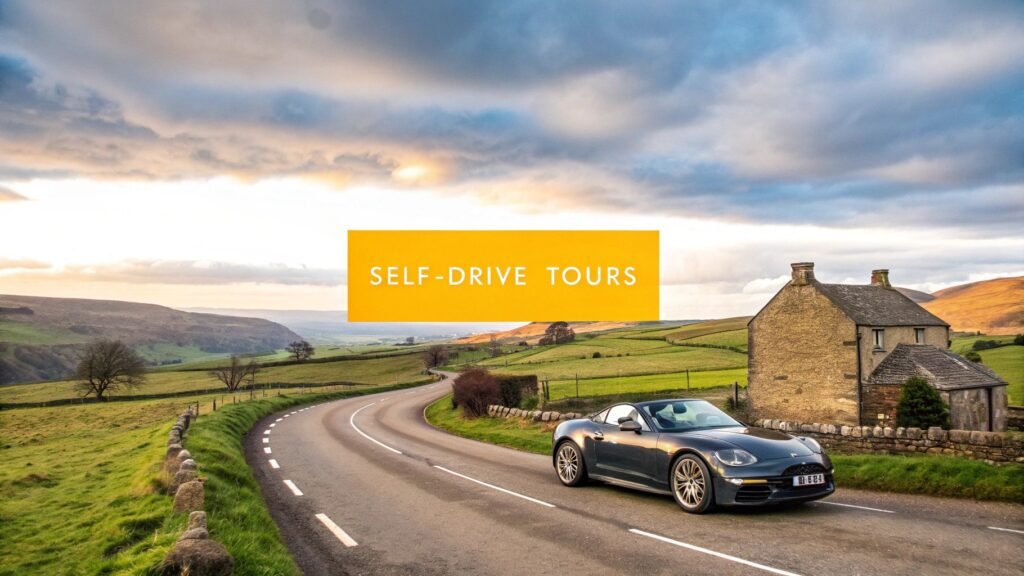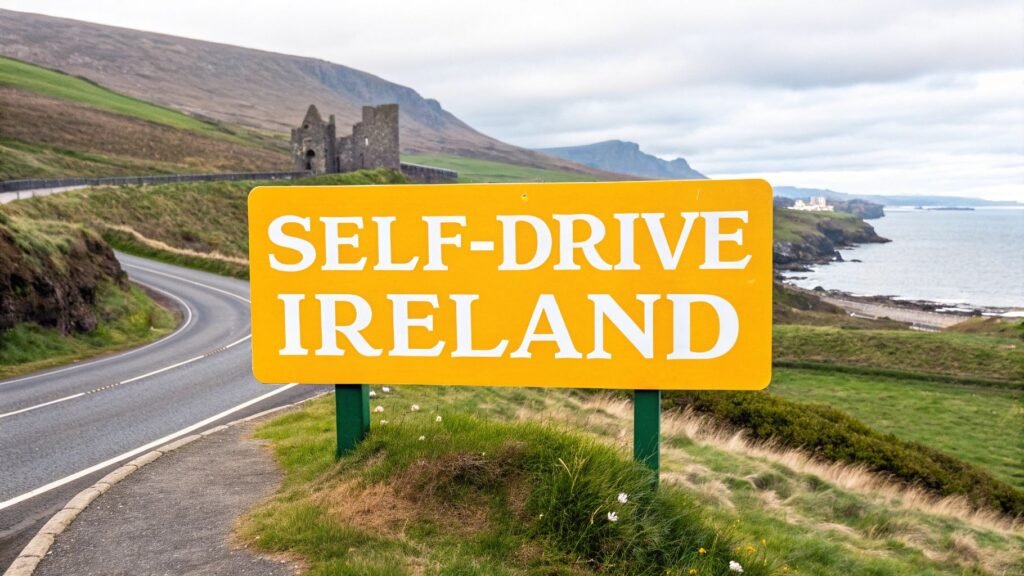So, you’re dreaming of a road trip. Fantastic choice. But how to plan a European road trip? Before you get lost in visions of coastal drives and mountain passes, a little bit of groundwork will make all the difference between a good trip and an unforgettable one.
Getting these first few decisions right—when to go, what you want to see, and what you’ll be driving—is the secret to a smooth, well-planned adventure.
Laying the Groundwork for Your Adventure

Think of this as building the foundation of your trip. The choices you make now will shape your budget, your route, and the entire feel of your journey. A bit of thoughtful planning at this stage prevents so many logistical headaches down the road.
Choosing Your Road Trip Season
The time of year you travel is probably the single biggest factor influencing your trip. It dictates the weather, how many hours of daylight you have, the size of the crowds, and what you’ll pay for accommodation. Each season offers a completely different experience.
Deciding on the perfect time for your European road trip can feel tricky. This table breaks down the pros and cons of each season to help you find the best fit for your adventure.
| Season | Pros | Cons |
|---|---|---|
| Spring (Apr – Jun) | Pleasant weather, blooming landscapes, and fewer crowds than summer. | Weather can be unpredictable in some regions; some mountain passes may still be closed. |
| Summer (Jul – Aug) | The best weather, long sunny days, and all attractions are open. | Peak season crowds, higher prices for everything, and heavy traffic in popular areas. |
| Autumn (Sep – Oct) | Beautiful autumn colours, harvest festivals, and thinning crowds. | Days get shorter, and weather becomes cooler and potentially wetter. |
| Winter (Nov – Mar) | Perfect for Christmas markets, winter sports, and finding solitude in the south. | Short daylight hours, cold weather, and potential for road closures due to snow. |
For my money, the “shoulder seasons”—late spring and early autumn—often provide the best of both worlds. You get decent weather without having to battle the peak summer crowds. It’s a smart way to get more value and enjoyment out of your trip.
Defining Your Trip’s Identity
What kind of adventure are you really after? Giving your trip a theme helps to focus your planning and stop you from feeling overwhelmed by all the options.
Are you picturing yourself cruising along sun-drenched coastlines like the Amalfi Coast or the French Riviera? Or are you a history buff who’d rather get lost in the medieval towns of Germany’s Romantic Road? Maybe the goal is conquering the hairpin bends of the Swiss Alps, or perhaps it’s a slow, indulgent culinary tour through Tuscany.
Pinpointing your main interest makes choosing countries and regions so much easier. As you think about the kind of journey you want, don’t forget the practicalities. Comfortable, quick-drying clothes are a game-changer on a long trip, so it’s worth checking out things like the best travel underwear picks for something durable that will last the distance.
Your Car or a Hire Car?
For those of us based in the UK, this is a big decision. Taking your own car has its perks: it’s familiar, comfortable, and you can pack as much as you can fit without worrying about airline luggage limits. You’ll just need to be absolutely sure your insurance, breakdown cover, and vehicle documents (like the V5C) are all in order for driving on the continent.
On the other hand, hiring a car can be a lot simpler, especially for a longer trip or if your own car isn’t quite up to the task. It also gives you the freedom to fly to a starting point much further away, saving you days of driving just to get there. Just be sure to check the small print for cross-border fees and insurance rules if you plan on hopping between countries in your hire car.
When you’re setting off, remember how busy UK roads are. In the 12 months ending March 2025, an incredible 335.9 billion vehicle miles were driven in Great Britain. That’s a stark reminder to always leave plenty of extra time for that initial journey to the ferry or Channel Tunnel.
Crafting an Itinerary That Breathes
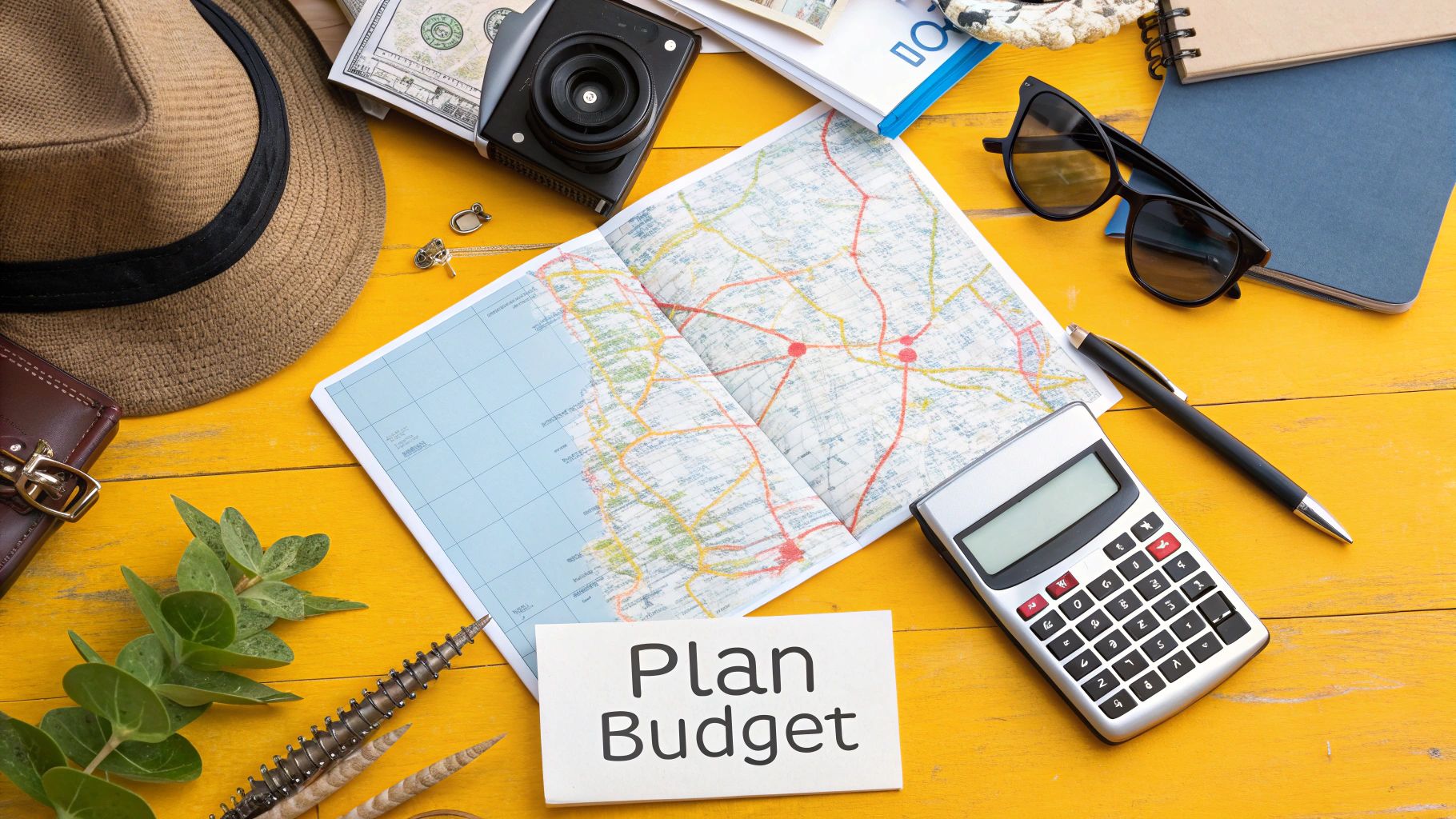
This is the fun part. It’s where your European road trip dream starts to feel real, taking shape on a map. A truly great itinerary isn’t just a list of places; it’s a living, breathing plan that perfectly balances time behind the wheel with time for discovery.
Forget just pinning places you want to see. The real art is connecting those dots in a way that feels like an adventure, not a logistical nightmare. The aim is to create a route that’s inspiring but, more importantly, genuinely achievable. Trust me, I’ve seen it time and time again: overambitious plans are the number one cause of road trip burnout. Let’s build a plan that actually has room to breathe.
Plotting Your Route with the Right Tools
Your first stop will probably be Google Maps, and for good reason. It’s brilliant for getting a bird’s-eye view of your route and a rough idea of distances and driving times. Start by plotting your absolute “must-see” locations. This gives you a basic skeleton to build upon.
A word of caution, though: don’t take those initial time estimates as gospel. Google’s calculations assume perfect conditions, no traffic, and certainly don’t factor in that spontaneous detour for a stunning viewpoint or a much-needed coffee break. As a rule of thumb, I always add at least 25% to any estimated driving time to keep things realistic.
For the finer details, dedicated road trip apps are an absolute game-changer.
- Roadtrippers: This is my go-to for finding those quirky, off-the-beaten-path attractions and scenic points you’d otherwise drive right past.
- Rome2rio: While it’s not a pure route planner, it’s invaluable for comparing the cost and time of driving against taking a train or bus for certain legs of your journey. Sometimes it just makes sense to ditch the car for a day.
- ViaMichelin: Fantastic for budgeting. It provides detailed route options, including estimated toll costs and fuel consumption. It also flags Michelin-recommended scenic routes, which are almost always worth the extra time.
By using a combination of these tools, you get a much richer, more practical picture of your journey. You’ll quickly see how to plan a trip that goes way beyond the soulless motorways.
A Note on Backtracking: A well-planned itinerary should flow logically, either as a big loop or a one-way journey. Constantly doubling back on yourself is a massive waste of precious holiday time and fuel. Lay your points out on a map and find the most efficient path. Sometimes this means shuffling your wish list to create a more sensible geographical flow.
Balancing Drive Days with Down Time
This is probably the most important lesson I’ve learned from years on the road. The temptation to cram everything in is powerful, but driving for eight hours day after day is a recipe for disaster. You’ll just see Europe through a windscreen and arrive at each destination too shattered to enjoy it.
A balanced rhythm is the secret.
- Limit Long Hauls: I try to never schedule more than two long driving days (that’s anything over 5 hours) back-to-back.
- Embrace the “Two-Night Rule”: For any town or city you genuinely want to explore, plan to stay for at least two nights. This gives you one full, unhurried day to immerse yourself.
- Build in “Zero Days”: Deliberately plan days with no driving at all. Use them to wander a city on foot, relax by a lake, or simply catch up on laundry and recharge your own batteries.
Think of your itinerary like a good piece of music—it needs rhythm. A long drive day should be followed by a shorter one, or better yet, a two-night stay. This is how you keep fatigue at bay and the sense of adventure alive.
Scenic Routes Versus Toll Roads
In Europe, you nearly always have a choice: fast and direct, or slow and beautiful.
- Toll Roads (Motorways/Autoroutes): These are your express lanes. They’re perfectly maintained and the quickest way to get from A to B, but they bypass all the local character. They can also get pricey, especially in countries like France and Italy.
- Scenic Byways (National/Local Roads): These roads are the heart and soul of your trip. They wind through tiny villages, lead you to local bakeries, and reveal views that you won’t find in any guidebook. They’re slower, for sure, but infinitely more rewarding.
The best itineraries, I’ve found, use a smart mix of both. Use the motorways to cover long distances between regions efficiently. But the moment you arrive in an area you want to truly experience—like the Cotswolds in England or the Alsace wine route in France—get off the big roads. This hybrid approach gives you the best of both worlds: efficiency when you need it, and unforgettable experiences when you want them.
Budgeting for Your Trip Without Guesswork
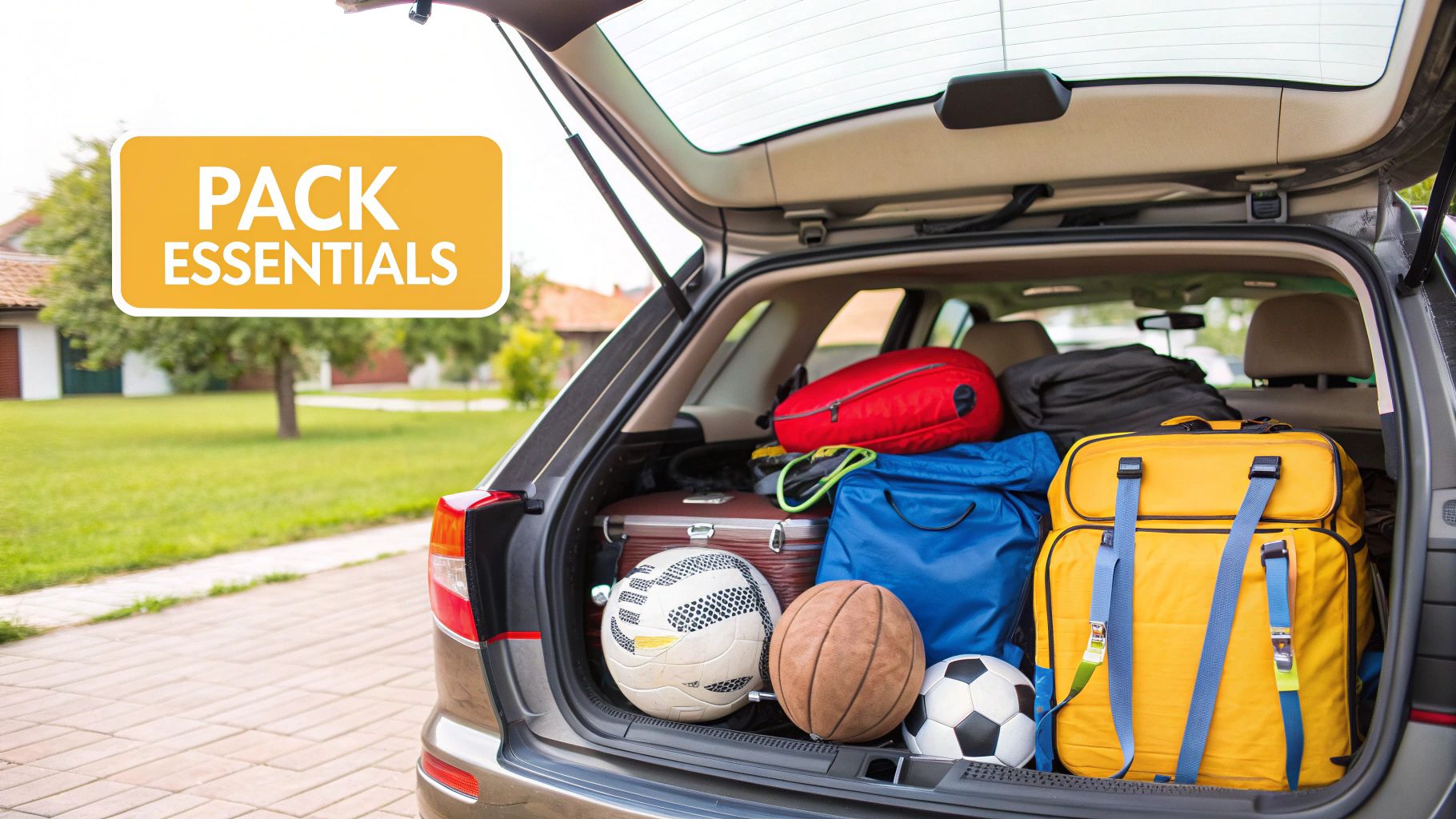
A European road trip is an investment in memories, but it shouldn’t leave your bank account empty. Getting your budget right isn’t about restriction; it’s about empowerment. It gives you the financial confidence to truly soak it all in, without that nagging worry about money. Let’s break down the major costs so you can plan with precision, not just guesswork.
First things first, there’s no magic number. Your final figure hinges entirely on your https://btours.com/travel-styles/. Are you a happy camper who loves a good picnic, or are you dreaming of boutique hotels and tasting menus? Be honest with yourself from the start, as this will shape every financial decision you make.
Breaking Down Your Core Expenses
To build a budget that actually works, you need to think in categories. I find a simple spreadsheet is the best way to make sure nothing important gets overlooked.
Here are the big ones to track:
- Fuel: This will be one of your biggest—and most unpredictable—costs. Fuel prices swing wildly from one country to the next. For instance, you’ll often find it’s cheaper to fill up in Luxembourg or Austria than in Italy or the Netherlands. A brilliant tool for this is a route planner like ViaMichelin; it can give you a surprisingly accurate estimate of your fuel spend based on your car and your route.
- Accommodation: Your nightly spend can be anything from £25 for a campsite to well over £150 for a city-centre hotel. Self-catering apartments or guesthouses often hit that sweet spot, giving you great value and the option to cook a few meals to save on dining out.
- Food & Drink: A smart strategy I’ve used for years is budgeting for one proper restaurant meal a day. Then, hit the local supermarkets for breakfast supplies and things to make packed lunches. It’s the perfect balance—you get to sample fantastic local food without your wallet taking a beating. And don’t forget to factor in those essential morning coffees and afternoon gelatos!
- Tolls & Vignettes: This is a classic rookie mistake. Many European motorways, especially across France, Spain, and Italy, have tolls that can really add up. On top of that, countries like Switzerland and Austria require a “vignette”—a prepaid sticker for your windscreen—to use their main roads. A bit of research here before you go will save you from hefty, on-the-spot fines.
Money-Saving Strategies on the Road
Knowing where your money is going is half the battle. The other half is actively looking for ways to spend it smartly. Those small savings you make every day really do make a huge difference over the course of a long trip.
Just for some perspective, UK travellers are used to budgeting for domestic trips. In the first quarter of 2024, the average overnight holiday in Great Britain cost £352, with a nightly spend of around £132. When you stretch that out over a few weeks in Europe, you can see how important it is to keep a close eye on your spending.
The Contingency Fund Rule: No budget is complete without a buffer for the unexpected. I always recommend setting aside an extra 10-15% of your total trip cost. This is your safety net for anything from a flat tyre to a spontaneous, must-do boat trip you hadn’t planned for. It turns potential stress into a minor blip.
Managing Your Money Across Borders
Figuring out how to pay for things is a key part of your pre-trip planning. The Eurozone makes life easier, but you’ll still need to think about different currencies if you’re heading to places like Switzerland (Swiss Francs), the Czech Republic (Koruna), or Norway (Krone).
A multi-pronged approach works best.
- Use a fee-free travel credit card for bigger bills like hotels and restaurants.
- Carry a modest amount of local cash for small purchases, market stalls, and those little cafes that might not take cards.
Getting a handle on exchanging money before you go is also crucial. For some solid advice, it’s worth learning how to exchange foreign currency for your trip. This will help you find the best rates and avoid being stung by hidden fees.
Getting Your Car and Paperwork in Order
Okay, with the exciting parts like your route and budget sorted, it’s time to tackle the admin. Getting your car and documents ready for a European road trip isn’t the most thrilling task, I’ll admit, but it’s absolutely vital for a stress-free journey. Whether you’re driving your own car across the Channel or hiring one on the continent, a bit of focused prep here will save you a world of headaches later on.
First things first, if you’re taking your own vehicle, give it a proper once-over. The last thing you want is a breakdown on a French autoroute or a German autobahn. A good starting point is a comprehensive car maintenance checklist to spot any lurking issues before you even leave your driveway.
The All-Important Document Wallet
When you’re driving in Europe, you need a dedicated folder with all your essential documents within easy reach. Trust me, having everything organised makes any border check or police stop a complete non-event.
Here’s what you absolutely must have with you:
- Driving Licence: Your valid UK photocard licence works just fine across the EU and Switzerland.
- V5C Logbook: This is a big one. You must carry the original V5C document. Photocopies won’t cut it.
- Proof of Insurance: Give your insurer a quick call to make sure your policy includes the minimum third-party cover required for driving in the EU. It’s usually standard, but it pays to be certain.
- MOT Certificate: Make sure your MOT is valid for the entire duration of your trip.
- UK Sticker: Since Brexit, a UK sticker on the back of your car is mandatory. The old ‘GB’ stickers are no longer valid on their own, so don’t get caught out.
It’s also worth noting that a handful of countries might still require an International Driving Permit (IDP). Always double-check the rules for every single country you plan to visit before you set off.
Thinking of Hiring a Car Instead?
Hiring a car in Europe changes the paperwork slightly, but the need for diligence remains. My best advice is to book with a well-known, reputable company. Make sure you pore over the terms and conditions, paying close attention to their cross-border policy. Some rental firms charge a hefty fee or even forbid you from taking their cars into other countries.
Also, get to grips with the insurance jargon. A Collision Damage Waiver (CDW) sounds comprehensive, but it usually just limits your liability to a very high excess. You can often save a significant amount of money by buying separate excess insurance from a specialist provider before you travel. It’s a simple move that could save you hundreds of pounds if you have a prang.
Your Onboard Safety Kit
This is where many travellers get tripped up. Different countries have different laws about the safety equipment you must carry in your car, and “I didn’t know” won’t get you out of an on-the-spot fine.
A classic mistake is assuming the kit for one country will cover you everywhere. For example, France insists on certified breathalysers (though they’ve waived the fine for not having one), while neighbouring Spain doesn’t. You have to check the rules for every country on your itinerary.
While specifics vary, your basic kit should generally include these items:
- Warning Triangle: This is a universal requirement across Europe.
- High-Vis Vests: You need one for every passenger, and they must be stored inside the car’s cabin—not in the boot!
- First-Aid Kit: Compulsory in countries like Austria and Germany.
- Headlight Converters: Essential for driving on the right to avoid dazzling oncoming traffic.
To make this easier, here’s a quick-glance table for some of the most popular destinations.
Compulsory Car Kit Checklist by Country
| Country | Warning Triangle | Hi-Vis Vest | First Aid Kit | Fire Extinguisher | Spare Bulbs | Breathalyser |
|---|---|---|---|---|---|---|
| France | Yes | Yes | No | No | Recommended | Yes (NF-approved) |
| Germany | Yes | Yes | Yes | Recommended | No | No |
| Spain | Yes (two) | Yes | Recommended | Recommended | Yes | No |
| Italy | Yes | Yes | Recommended | Recommended | No | No |
| Belgium | Yes | Yes | Yes | Yes | No | No |
| Austria | Yes | Yes | Yes | Recommended | No | No |
Remember, this is just a guide. Rules can change, so a final check on an official site before you travel is always a smart move.
If you love the idea of a road trip but find the logistics a bit daunting, letting an expert handle the planning can be a fantastic alternative. For a bit of inspiration on what’s possible, take a look at these expertly crafted self-drive tours that remove all the planning stress.

As you can see from the chart, even within Western Europe, accommodation costs can differ quite a bit. This kind of information is brilliant for helping you decide where to spend more time and whether you’ll need a car with enough boot space for camping gear or just enough for a couple of suitcases for hotel stays.
Booking Your Crossings and Stays
With your route sketched out and a budget in place, it’s time for the exciting part – making it real. Locking in your Channel crossing and your first few nights’ accommodation is when a dream trip starts to feel like a tangible plan.
Getting this stage right is a balancing act. You’re juggling cost, convenience, and the overall vibe you want from your holiday. A bit of smart booking now saves a world of hassle later on and guarantees a comfy bed after a long day’s drive. Let’s get into the nitty-gritty of securing those crucial reservations.
Securing Your Channel Crossing
For anyone starting in the UK, the first hurdle is getting across the water. Your main choices are the Eurotunnel Le Shuttle from Folkestone to Calais, or a ferry from ports like Dover, Portsmouth, or Newhaven. I’ve used both countless times, and they each have their own clear benefits.
Eurotunnel Le Shuttle:
- Speed: This is, without a doubt, the fastest option. The crossing takes a mere 35 minutes. You just drive onto the train carriage, and before you know it, you’re rolling onto French soil.
- Convenience: The whole process is incredibly smooth. You never leave your car, which is a massive plus if you have kids or pets in tow. No fuss, no drama.
- Reliability: The tunnel is almost entirely immune to bad weather, offering a level of certainty that ferries sometimes can’t match on a stormy day.
Ferries:
- Value: Ferries often work out cheaper, particularly if you book well in advance or can travel outside of peak hours.
- The Experience: For many, the ferry trip is the start of the holiday. It’s a chance to get out of the car, stretch your legs, have a meal, and watch the waves from the deck.
- Flexibility: With ferries sailing from various UK ports to France, Spain, and the Netherlands, you might be able to start your drive much closer to your ultimate destination.
Honestly, the choice comes down to your priorities. If you just want to get to the continent as quickly and easily as possible, the tunnel is your best bet. If you’re not in a rush and fancy a more traditional, wallet-friendly start to your adventure, you can’t go wrong with a ferry.
Planning Your Accommodation Strategy
Once you’re on the mainland, you’ll need places to rest your head. The secret to a successful road trip accommodation plan is finding that sweet spot between planning and spontaneity. My golden rule is to always book the first and last nights in advance, along with any stays in major cities or must-see national parks.
This gives your trip a solid backbone but leaves plenty of room for those unexpected detours. For the nights in between, driving through quieter regions, you can often find fantastic local guesthouses or roadside hotels at the last minute. This mix of planning and freedom is, for me, the essence of a great European road trip.
Here’s a pro tip I swear by: book accommodation with free cancellation policies. It gives you the security of a confirmed room but the flexibility to change your mind if you stumble upon a village you can’t bear to leave.
It’s also worth noting that travel is getting busier. VisitBritain’s 2025 forecast, for example, is anticipating 43.4 million inbound visits to the UK. This surge will put pressure on key transport links like ferry ports and the Eurotunnel, making it all the more important to book your crossing early. You can read more on the official VisitBritain website.
If you need some inspiration, especially for the urban parts of your journey, having a look at different city breaks can spark some brilliant ideas. It helps you get a feel for the types of places you might enjoy, from chic boutique hotels to practical, centrally-located apartments.
Got a Few Lingering Questions?
Even with the best-laid plans, a few “what if” scenarios are bound to pop into your head. Knowing the answers to common road trip problems before you’ve even packed the car is the final step to a truly stress-free adventure.
Think of this as your practical, on-the-road FAQ. We’re tackling the real-world stuff that can come up, from a dreaded breakdown on a foreign motorway to figuring out the labyrinth of driving rules in big European cities. Getting these sorted will give you the confidence to just enjoy the drive.
What Should I Do If My Car Breaks Down in Europe?
The thought of a breakdown abroad can be unnerving, but if you’re prepared, it’s more of an inconvenience than a disaster. The absolute first thing to do is make sure everyone is safe. Pull over as far to the side as you can, switch on your hazard lights, and get everyone out of the car, preferably waiting behind a safety barrier.
Once you’re in a safe spot, it’s time to act.
- Get your safety gear out. Place your warning triangle a good distance behind your car to alert oncoming traffic—that’s about 50 metres on a normal road and 150 metres on a motorway. Crucially, everyone who gets out of the car must put on a high-vis vest. This isn’t just a good idea; it’s a legal requirement in many countries.
- Call your breakdown provider. This is the moment you’ll be glad you organised European breakdown cover. Ring the dedicated European assistance number from your UK provider (like the AA or RAC). They’ll do the heavy lifting, from finding a local garage to sending a recovery truck. Keep your policy number handy.
- No cover? Dial 112. If you decided to go without a specific policy, the universal emergency number across Europe is 112. You can call this from any mobile to get through to local emergency services who can help.
My best piece of advice? Sort out your European breakdown cover before you leave home. Trying to buy a policy when you’re already stranded on the side of a road is usually impossible and will always cost a fortune. It’s a small price to pay for a huge amount of reassurance.
How Do I Handle Tolls on European Motorways?
Ah, the tolls. European motorway tolls can seem confusing at first because there’s no single, unified system. It changes from country to country, so knowing what to expect is the key to a smooth drive and avoiding any surprise fines.
Here are the main systems you’ll come across:
- Pay-as-you-go Booths: This is the classic system you’ll find across France, Spain, Italy, and Portugal. You grab a ticket when you get on the motorway and pay with cash or a card when you exit. A word of warning: some automated booths can be fussy about UK cards, so keeping some Euros in cash is a very smart move.
- Electronic Tags: If you’re spending a lot of time in France, a ‘Liber-t’ tag is a revelation. It’s a small electronic box you stick to your windscreen that lets you sail through the dedicated express lanes. The toll is billed to your account automatically, saving you from long queues.
- Vignettes (Stickers): Countries like Switzerland, Austria, the Czech Republic, and Slovenia use a different system. You need to buy a prepaid sticker, called a ‘vignette’, and display it on your windscreen. You can usually buy these at border crossings, petrol stations, or online before you go. Don’t risk it—driving on a motorway without one will land you a hefty on-the-spot fine.
Checking a national motoring organisation’s website before you set off is a great way to see the specific requirements for your route. This helps you budget properly and keeps the journey flowing.
Are There Special Driving Rules in European Cities?
Yes, and this is something every modern road-tripper needs to be aware of. To tackle air pollution, hundreds of cities across Europe have brought in Low Emission Zones (LEZs). These zones restrict which vehicles can enter based on their emissions standards.
The tricky part? The rules are different everywhere.
- France’s Crit’Air System: Major French cities like Paris, Lyon, and Strasbourg require you to display a ‘Crit’Air’ sticker. The colour of your sticker is based on your car’s Euro emissions standard, and on polluted days, vehicles with certain stickers might be banned from the city centre. You have to order this sticker online well in advance of your trip; you can’t just pick one up when you get there.
- German ‘Umweltplakette’: It’s a similar story in Germany. To drive into most city centres, you’ll need an ‘Umweltplakette’ (environmental sticker). You can get these online or at approved testing stations inside Germany.
- Other City-Specific Rules: Cities like Brussels, Antwerp, and London have their own LEZ or ULEZ (Ultra Low Emission Zone) rules. These often require you to pre-register your vehicle online before you arrive, even if it meets the standards.
Failing to follow these rules can lead to very expensive fines being posted to your home address months after you get back. Before you go, list the major cities you plan to visit and check their LEZ requirements on their official city websites.
Can I Use My UK Licence and Insurance in the EU?
For most holiday road trips, the answer is a simple yes. A valid UK photocard driving licence is all you need to drive throughout the EU and Switzerland. You don’t need to get an International Driving Permit (IDP) for these countries.
When it comes to insurance, your UK policy automatically gives you the minimum legal third-party cover required to drive in the EU. However, you should always phone your insurer before you travel. There are two important reasons for this.
First, you need to check if your fully comprehensive cover extends to Europe. Sometimes it’s included as standard, but often it’s an add-on you need to pay for. Second, while a ‘Green Card’ is no longer a legal requirement for most of the EU, some insurance companies might still ask you to carry one as proof of your policy. A quick call will clear everything up and make sure you’re properly protected.
Planning a European road trip is an incredible experience, but let’s be honest, piecing it all together can feel like a full-time job. If you love the freedom of the open road but would rather have an expert handle the logistics, BTOURS can help. We specialise in crafting unforgettable self-drive tours, finding the best routes and hand-picking authentic places to stay, so all you have to do is focus on the adventure.

